#good omens costume meta
Text
I broke down the hilarious amount of "Aziraphale tartans" so you don't have to.
I've been slowly going bonkers collecting the amount of times members of the cast/creators and fans of Good Omens over the years have referred to various things as "Aziraphale's tartan". Even on merchandise, I've seen wildly varying opinons about what pattern Aziraphale's tartan actually is. Your resident graphic designer has decided to sit down and just do the damned thing*.
Exhibit A) Tartan Origin

Sarah Arnett posted this image to her instagram in 2019, having created "Heaven's dress tartan for the character Aziraphale". However, the only time I've actually seen this pattern used in good omens is in the season 2 announcement poster made by Mickey, and maybe on a pair of socks Aziraphale wears in season 1, (but I'm not convinced).
So here's what that looks like. Note I've rotated the original pattern 90 degrees clockwise in my final pattern (far right) for reasons that will become clear shortly.

Exhibit B) Aziraphale's Bowtie, Thermos, Notebook etc.

This is the tartan that Aziraphale actually wears for most of seasons 1 & 2.** It's a recoloured version of the Exhibit A), and has been rotated 90 degrees on it's bowtie application so that the darker bars run vertical, and not horizontal. The problem is, while the direction of the pattern on his accessories doesn't change, it does on the bowtie. You can see examples of the tartan going right OR left in both season 1 and 2.
Exhibit C) Aziraphale's Brown Bowtie...

This Tartan isn't just a trick of the light. For the first park bench scene in season 1, Aziraphale is wearing a version of his regular bowtie, recoloured in brown and rotated 90 degrees, so that it fits with the direction of the original Exhibit A) Tartan, but not with the direction of the tartan on his Exhibit B) regular bowties. This bowtie was made special, from cloth cut in the opposite direction.
Exhibit D) Aziraphale's Magical Cravat!

Now this is where it starts to get interesting! I haven't seen many people discuss Aziraphale's magician disguise from season 1, but his cravat actually has both Exhibit B) and Exhibit C) tartans to create a contrasting double sided tartan: the outward facing brown, and the hidden, inward facing blue (according to costumer, because of lack of enough brown).
Exhibit E) Saraqael's and Muriel's Tartan
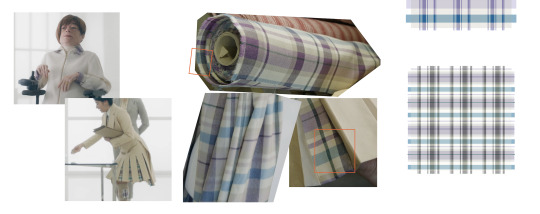
Don't be fooled, Saraqael's and Muriel's tartan may look similar in colour to Aziraphale's, but when you pick it apart, it's got inverse colours, and mildly squished horizontal striping. If you note the orange boxes in each picture, you can see the ratio of the blue stripe to the vertical stripes in each tartan is different, while keeping the overall pattern and ratio in each direction the same. Exhibit E) has a square intersection. It's also usually woven much larger. This tartan also introduces a small sliver of hunter green into the beige/blue/purple palette that's been seen so far.
Exhibit F) Gabriel's Tartan Blanket

Like the others, Gabriel's S2E1 blanket is a variation on the original Heaven's Dress Tartan. It's got very squished horizontal striping though, and is woven even larger than the Saraqael Tartan. Most noticeably though, while it has the same grey vertical striping as Exhibit E) it's now got even more green in it, and the purple is gone almost entirely (save one line).
Exhibit F) Have a bonus Crowlee Tartan from the Season 1 body swap miracle that matches none of these.

It's silver silk though. Can I get a wahoo....?


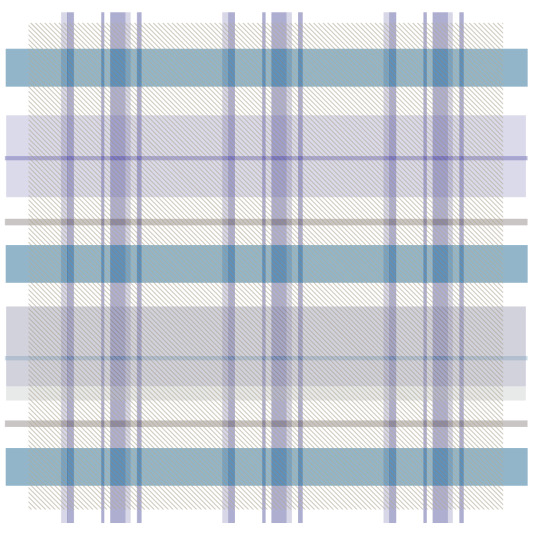
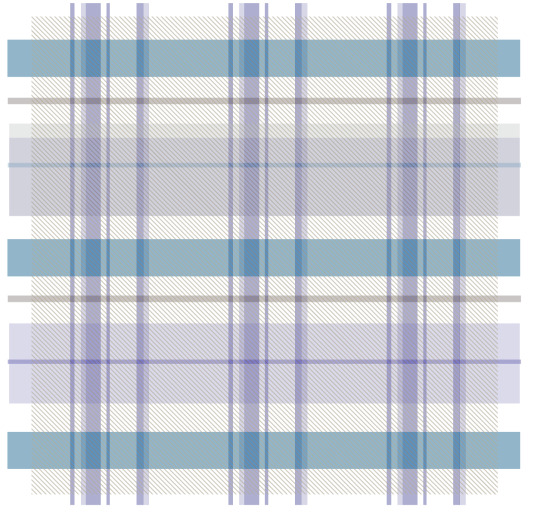

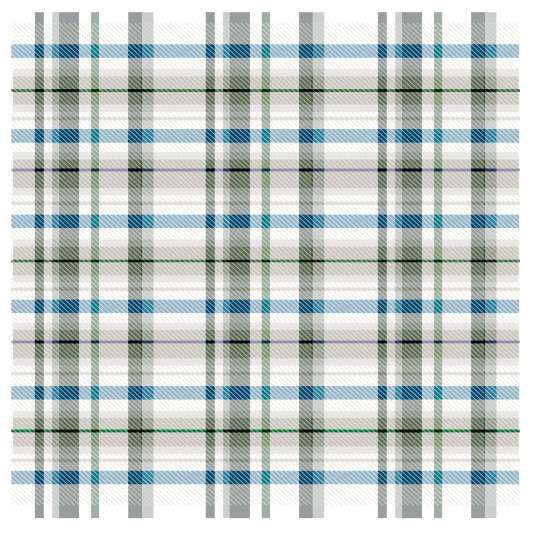
__________________________________________
*Disclaimer: I am not Scottish, and definitely not an expert in tartan, just a tired graphic designer. If you want tartan expertise, you can go here (although I don't really agree with what they say about the main colour pattern) https://livebloggingmydescentintomadness.tumblr.com/post/189300035060/a-discourse-on-tartan
**In order to deduce colours, I've used high quality BTS footage or photography in neutral lighting whenever possible. Especially in season 2, colour grading and post processing of the final show make colour matching between scenes and/or seasons impossible.
#good omens 2#art director talks good omens#go season 2#good omens season 2#good omens season two#good omens#good omens prime#go1#good omens season 1#tartan#crowley x aziraphale#aziraphale and crowley#aziraphale#costume#good omens costume meta#good omens analysis
470 notes
·
View notes
Text
The Assistant Book Seller
Edit 1 Dec 2023 - added missing information on the "ribbon pattern."
Edit: 3 Dec 2023 - correct information about middle pattern from creator
GABRIEL: Greetings! I'm Jim! It's short for James, but I don't need to keep telling everyone that. I'm an assistant book seller.
I'm sorry. Before I do anything else, I need to apologize for something I need to write further in. I didn't plan to write it, I just kind of bumped into it and, well, I can't ignore it. So...sorry. It's said. Forgive me for what needs to be done.
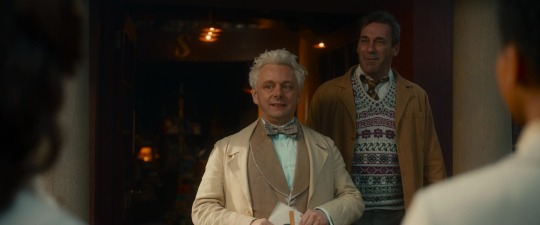
Although he arrived with nothing but a cardboard box and Rodney the Stunt Fly, Aziraphale made sure Jim was clothed in appropriate raiment while under his protection. We'll forgive him that he took a step back about, oh, fifty years or so to the 1970's, as Jim's overall look is a nod to the famous old sitcom "Open All Hours." So if he looks a little bit out of place, or, a little bit familiar, even, that's why.
While we are used to seeing angels in overcoats, it's Jim's vest that is the particular feature here. But I will take a moment to comment on the overcoat - not just the colour but its lapels. Aziraphale has obviously given him a colour with an earthly connection and one that indicate that he has bought Jim under his protection, but the lapels look quite neutral, with one up and one down. (Muriel is the same in their Inspector uniform, btw) This is the first indication they are between two things at the moment.
Onto the vest.
There is so, so much work and thought put into this vest! It was a one-off commission for the show, and the creator, Sandy Higgins, has said she is not allowed to give away the final design pattern. I have tried to contact her, and I'm waiting for a reply, so in the mean time I thought I would ask my keen knitter of a sister-in-law about one of the patterns I'm not sure about. "Well, that's Fair Isle knitting," she said, but she knew nothing about the individual line pattern I was interested in. Hmm, I kind of know that already, its in the notes that are guiding me for this meta, but hey, why not do a broader search and see what comes up?
So once I got back home I did. "Fair Isle knitting patterns" hmm...Wikipedia page for starters...what on *earth* is that at the bottom of the page...? YOU ARE. FRIKKING. KIDDING ME!!!!!!!

"See also: Gumbys"
oh ffs
I am so sorry that needs must make me mention Monty Python yet again, but here we are. And we must mention them, because this link is just too...unbelievably, deliciously good.
If you aren't familiar with the Monty Python catalogue, and don't recognize the mention of Gumbys, they were a set of characters that dressed and spoke in a certain way but the main points to take away were they wore woolen vests in the Fair Isle knitted style and their catch-phrase was - wait for it - "My brain hurts!"
I think we've heard that somewhere before?
CROWLEY: When you first arrived, you said you were here because they were planning to do 'Something Terrible' to you. So you remembered it then. Remember it now.
GABRIEL: It hurts to remember. My head isn't built for that.
Right. Now we've got that out of the way...back to the serious stuff.
The colours used in the vest are not your typical angel colours. There is a base of angelic off-white and there are some bits of purple for his royalty around the shoulder area - sometimes you need to look carefully for it. Otherwise it is dominated by vintage shades of red and green. Well. Who's an agent of change driven by love, then?
The horizontal stripe pattern is partly to remind us of the classic biblical robes with stripes that ran along them, much like the style of Crowley's black and red robe in the Job minisode, but is also part of the traditional Fair Isles pattern work. And each row only has two colours, but up around the shoulder area we do see purple start to sneak in as a third colour.
On to the incorporated symbols! I'm going to go from bottom to top.
On the lowest two we feature Crowley and Aziraphale. We have Crowley's demon satyr tail from the Good Omens logo on the lowest stripe - the double-headed arrow.
The next stripe is Aziraphale, with a variation of the classic OXO pattern ("hugs and kisses.") The X is meant to represent his angel wings, and the O is modified to mimic the "o" with a halo in the Good Omens logo. I've highlighted all three in the image on the right.
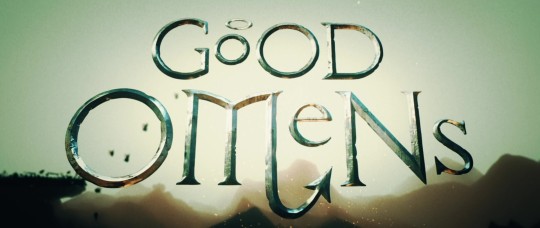

The third row up is a Sumerian Star pattern that represents one of the flowers associated with Gabriel, the lily. They are supposed to represent the purity of Mary, mother of Jesus, as he had one in his hand when he visited her during the Annunciation.
The row above that is what I believe to be a Byzantium pattern, and is included to show "an Angel's ability to be timeless."

The next three rows are still under a bit of a question mark as I write this. I plan to come back and edit it in if I find the answer.
The bottom of the three is the Duke of Buccleuch pattern, "to celebrate the long and necessary contribution that the cottage industry of hand knitted items."
The middle one - ? (perhaps you, the reader, know? It looks like a spiralling ribbon if I stand back, but that isn't sparking any connections, either.)
Edit: @noneorother tells me in a reblog (below) that this pattern represents the shoelace from the magic incantation Aziraphale uses "Banana Fish Gorilla Shoelace." So it is ribbon-like! This then points to the Second Coming, as it the shoelace references the end of the book, and the last paragraph of the book references Yeats poem "The Second Coming" as well as the novel 1984. To me it is then also telling us there is a cycle occurring, or a cycle that needs to be renewed. This fits in with some other clues other meta-writers have been picking up.
Edit 2: Turns out none of that was correct - I heard back from the creator herself and it's actually the double-ended satyr tail pattern again! It just seems to make a bit of an illusion of a ribbon or shoelace.

The pattern below is a modified OXO pattern.
The top one looks like two rams horns facing each other. A hollowed out rams horn can be used as a trumpet, and is known as a shofar in Jewish religion. Gabriel was traditionally known to carry a trumpet.


The ancient meander pattern would be recognized by most people, included as another classic timeless pattern found all over the world. For some it symbolizes eternity and endless flow.

The wheels here appear to be Michael's ophanim wheels, that would have eyes around the rims.
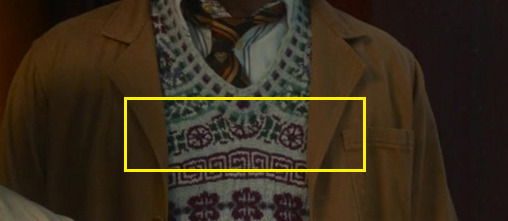
The hourglass is to remind us that time is running out. Memento mori - "Remember that you die." It is a major theme in both series.

Right up high, just before we lose the rest of the vest inside the overcoat, we get a glimpse of a large diamond-shaped icon. I wonder if this is another stylized set of angel wings, like we saw in the Job minisode on Aziraphale's golden collar.
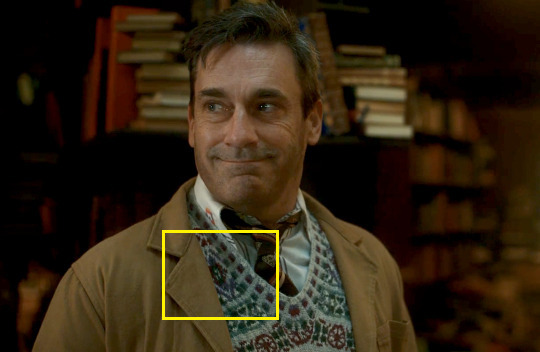
To finish off the outfit, he is wearing dark gray trousers with sneakers! I'm sure that's so he could keep sneaking up on Aziraphale in the shop, haha. His shirt seems a little too large for him and the tie is knotted too high and is not settled along his centerline. It's all at odds with his previous neat and sharp appearance as Supreme Archangel Gabriel.
I'd like to say a big thank you to @aduckwithears for helping me with information on the vest and finding the creator's other social media sites. You can see their two posts about it here and here.
#good omens#good omens 2#good omens meta#good omens analysis#aziraphale#gabriel#jimbriel#jim's vest#satyr tails#angel wings#halos#lily#meander pattern#rams horn pattern#hourglass#memento mori#open all hours#good omens costume meta#monty python#gumbys#my brain hurts!#fair isle
330 notes
·
View notes
Text
The costume details in Good Omens never cease to amaze me
I was working on cosplay research and looked up 'men's dress shirt rounded collar' since I noticed Aziraphale's blue dress shirt collar is rounded, not pointed:
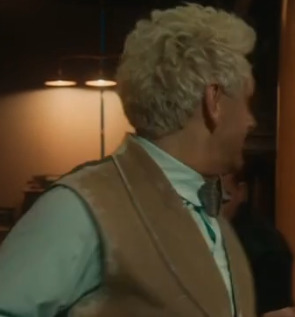
So it turns out...
"The rounded collar was part of Eton College‘s dress code beginning in the mid-1800s. Because men wanted to be perceived as belonging to this exclusive club, the rounded, or “club” collar was copied by the masses." (Source)
Between that and the fact that Aziraphale's waistcoat, from what I can find, most closely matches shawl collar waistcoat designs from the 1830s, and his waistcoat at Saint James Park in 1862 is the first one we see him wear that most closely resembles his 'modern day' one, it's safe to say our lad is stuck at the start of the 19th century.
Which COULD be hilarious given undergarment styles of the time:
Through the late 19th century - union suits! Lovely for cold London winters.
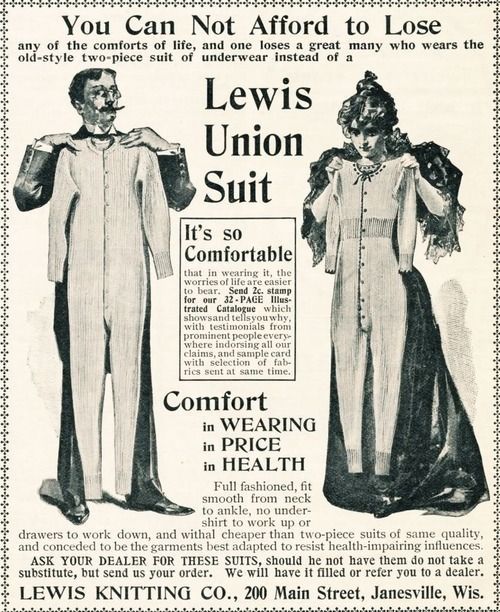
1907...
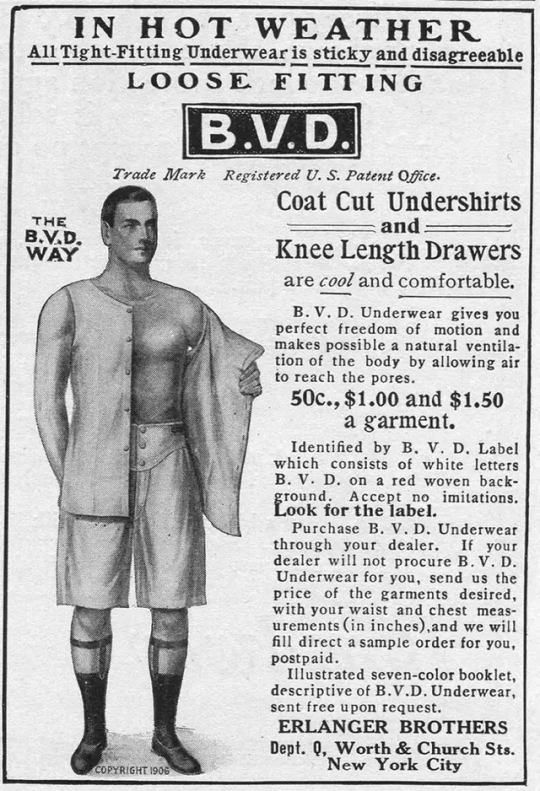
However, I suspect 1940s style to be most likely, as it seems to be what he emulated when pretending to be Crowley at the end of Season 1.
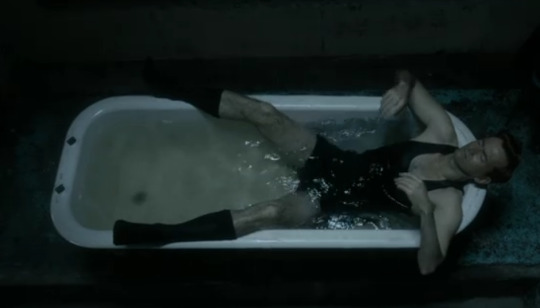
1940s undergarments:

Anyway this has been your fashion history dork brain dump LOL
#fashion history#historical fashion#good omens#good omens costumes#good omens cosplay#aziraphale#crowley#IneffabLeigh's Meta Tag
427 notes
·
View notes
Text
CORRECTED & UPDATED! Clothes + Equivocation = Romance:
The Husbands in 1793
EDIT: I made a significant error when I wrote this. As @goodjomans kindly points out in the comments to Part 2 of this essay (massive shoutout for this, goodjomans! also I love your name!), Aziraphale is the one who dresses the executioner in clothing like Aziraphale's original ensemble, not Crowley. This changes my conclusions about the meaning we can take from this scene!
On the one hand, mea culpa, y'all. I shall get on with eating my crow. On the other hand, I had to go through this frame-by-frame to catch which of the ineffable spouses puts Jean-Claude in his new togs, and the answer only lasts three frames. Here it is:
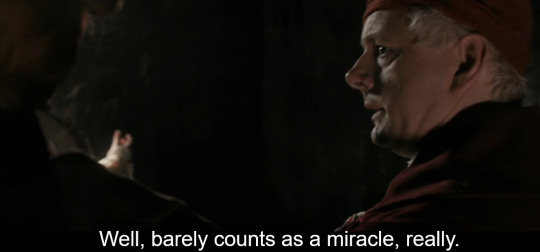
After Aziraphale changes his clothes, but before Crowley snaps his fingers and unfreezes time, there's a shot of the executioner over Crowley's shoulder, and he is now wearing a light coat with gold embroidery on the shoulders like Aziraphale's. Aziraphale arranges the executioner's death, not Crowley. So I feel like an idiot for missing it, but not a total idiot.
Let's discuss how this information changes what we can read from this scene! I'm going to leave my original text in place and edit with bold green. I can still stand by most of this essay, but this detail changes how I read the meaning of the husbands' communication at the end of this scene.
So we're all clear on the fact that the universe of Good Omens is an inescapable nightmare dystopia in which either of the husbands' merciless authoritarian regimes could be watching or listening to them at any time, yes? And that if either are caught 'fraternizing' with the other that means discorporation, torture, memory wipe, and/or death for either or both of them, yes?
Which means Crowley and Aziraphale can never speak or do anything openly to each other about their friendship or attraction or love. Everything they say and do has to have an innocuous meaning they can point to in case anybody ever sees or hears something Team Azcrow can't explain away. Walls (and ducks) have ears, and the price of slipping up--as we see in 1827--is heavy.
When a character says or does something that has two distinct meanings because they need to disguise what they really mean from one party but make their meaning plain to another, lit-nerds (and lit nerds🍃) call this equivocation. Equivocation is a kind of coded communication meant to pass hostile ears and eyes in plain sight but reach its intended recipient with its true meaning. The 1793 scene is jammed with it.
A lot of that coded messaging revolves around the clothes Crowley and Aziraphale choose in this scene, so--THESIS PARAGRAPH, BITCHES--we're going going to talk about how their clothes read to the people of this time period and location, what their clothes tell us about their characters, how their clothes help them equivocate, and what they're really saying with that equivocation. And Spoiler A-fucking-lert, it is ROMANTIC AF PRETTY GD ROMANTIC. Let's get nerdy!
We start with Aziraphale's beautiful champagne-gold and powder-pink ensemble.


This outfit would tell people of this time period 3 things about Aziraphale:
That he's insanely wealthy--These clothes would be silk, hand-embroidered with thread made with actual gold. Each individual garment could cost years' or even decades' worth of working-class wages and take a team of skilled artisans dozens to hundreds of hours to make.
That he's a fop--i.e., a man who loves fine clothes and dressing up and looking fancy. By the 1790s in England, once-fashionable foppishness was giving way to the Neoclassical 'Corinthian' style, and was considered effete. (Fun note: During this time period, effete did not automatically indicate gay, and pink was considered a masculine color, so while Az. is queering it up to the audience here, his clothes would not have read as gay or overtly effeminate to the other characters around him.)
Even though he's insanely wealthy, Aziraphale wears clothes that are decades out of fashion.
According to the Victoria & Albert Museum, "As the [18th] century progressed, the male silhouette slowly changed.[...] Coat skirts gradually became less full and the front was cut in a curved line towards the back. Waistcoats became shorter. The upper leg began to show more and more[...]. Shoes became low-heeled with pointed toes and were fastened with a detachable buckle and straps or ribbon[.]
Source
That description is not what Aziraphale's wearing. Judging by his heel height and the length of his waistcoat, Aziraphale is wearing a style that's at least a decade older than this:
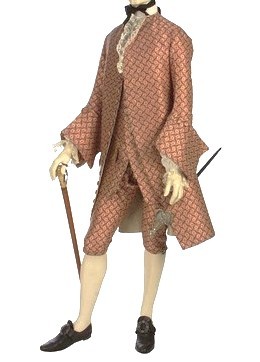
And this is from 1765. The great crepes caper happens in 1793, almost 30 years later.
My inference: Just as he has in the modern period, Aziraphale has settled into a style he really likes and refused to let go of it long after it's gone out of fashion.
We'll come back to this set of Aziraphale's clothes in a bit, but we need to talk about Crowley's first, because Crowley's clothes in this scene help render a line he says later about this outfit very flirtatious and darkly romantic.
First, some background: What was considered acceptable attire for wealthy people in France changed pretty much overnight during the French Revolution after the storming of the Bastille in 1789 and the fall of the French monarchy. Instead of advertising wealth, clothes now had to advertise political allegiance, and they had to do so loud and clear. And if you didn't want to be murdered by the French First Republic, that political allegiance had fucking better be to the Revolution.
People started wearing a looooooot of super patriotic shit. And I mean it was like little kids on the 4th of July; clothes were red, white, and blue in any hue and garish combination and print. The cockade, a fabric rosette in the colors of the French flag, was required by law to be worn by men, and despite that was just as popular among women. To show solidarity with the laboring classes, the fabrics the wealthy wore went from embroidered silk in light Rococo colors (what Aziraphale is wearing) to sober neutrals without decoration in wool, cotton, and linen.
Now, the script note for Crowley's clothing in this scene is this:

But clearly there were some changes made between script and filming, because Crowley does not appear standing behind Aziraphale; he appears lounging.
And he's not dressed as a French peasant.
Here's how French peasants dressed in 1790:

Peasants at this time wore styles that distinguished them from the styles of the upper classes not just in materials, colors, or patterns, but in shapes. Full trousers and cropped boxy jackets in French flag colors were the marks of the laboring-class Revolutionary, and both styles were huge changes from hundreds of years of French fashion up to that point.
And that's not what Crowley shows up wearing. Crowley is wearing the knee breeches, stockings, waistcoat, and frock coat of a wealthy man, and in fact his clothes reference a very specific type of wealthy man.
In the 1790s, if you were an aristocrat who wasn't happy about the Revolution and you were so sure of your privilege that you would risk your life showing it, you wore black in mourning for the monarchy and in protest of the violence of its deposition. If you were an aristocrat who wanted to protest and you didn't want to be immediately murdered by the French First Republic, you wore a style called half-mourning, which was black with a colored coat.
Here's a picture from a 1790 fashion magazine of an aristocrat in half-mourning:

"The text accompanying the plate describes his ensemble as 'half-mourning,' referring to the aristocrats who lamented 'the diminished powers of the monarchy and [signaled] their willingness to die for the royal cause'" [emph. added]. [Source]
Notice: the shoes, stockings, breeches, waistcoat, and cravat are all black. You with me?
Because here's Crowley in 1793:

I've turned up the brightness and exposure in this image so he's more clearly visible against the stone, but I haven't warmed it up. He's wearing a coat that's a dark blackish red. Everything else, even his cravat, even his shirt, is black. (The black shirt is anachronistic, a lovely little nod to Crowley's refusal to wear angelic white.)
This is 179fuckin'3, y'all. Marie Antoinette is executed in 1793. It's 3 full years after that fashion plate up there in his bright red jacket, and that lil dude was already risking his neck way back in 1790. As we can see from the fact that the government are apparently now grabbing random wealthy-looking Englishmen off the street to murder without trial, the time for a man demon to be sauntering around Paris dressed in all black or even nearly all black is well past.
Crowley's also wearing a whole assload of huge silver buttons, which would have been flashy and tacky and frankly pretty weird in 1793 but very definitely an eccentric Rich Person Thing to do, bc regular buttons at this time were horn or wood and covered with the garment's fabric. The only man in France who could get away with this fancy aristo shit anymore was Robespierre himself, and only "devotion to the cause[...] excused Robespierre’s showy dress since he was perceived as a bridge between the politically empowered bourgeois deputies and the ardently antimonarchical unenfranchised classes." [Source]
So when Crowley teases Aziraphale--
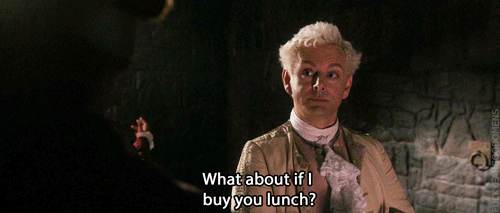

--both of them are perfectly well aware that Crowley's outfit would get him just as killed as Aziraphale's.
And that's why Aziraphale's expression is annoyed when he has abandon his "standards" and change his clothes. Because Aziraphale's the one who needs the favor, Crowley makes him take one for the team and wear the goofy hat.

The clothes Az. changes into here still tell people that he's rich, but they also say he's a hardcore Revolutionary. The red jacket in a current cutaway style, the cockade and sash, and the bonnet phrygien (the red garden-gnome cap) all announce this guy is a huge supporter of the Revolution. His clothes are all still aristocratic in shape and materials (and he keeps his now-unfashionably frilly lace cravat), but he's no longer flaunting obscene wealth in a city filled with angry starving people, and the gnome cap says he's in solidarity with the working classes even if he isn't one of them.
Once he restarts time, Crowley is not leaving that prison cell safely without either changing his clothes or taking Aziraphale with him, because Crowley looks like a rich asshole protesting the fall of the monarchy--which is frankly exactly the kind of thing he'd show up wearing to the Bastille during the Reign of Terror (just like he wears athleisure in Heaven). But Aziraphale's new appearance covers for them both: if the rich-looking guy with no cockade and wearing all black under his almost-black coat is in with this other guy who's obviously a Revolution fanatic, then the rich guy's probably okay, right? He just forgot his sash at home or something. Bees.
Something else happens when Az. changes, too. Look at Aziraphale's new dress from a different angle:
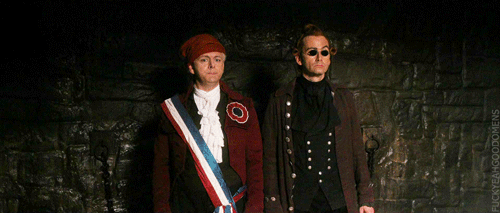
Half-mourning is a white shirt, but a black cravat, so this isn't half-mourning. He's wearing three different badges of the Revolution to make up for the fact that Crowley looks like a Satanic libertine (which tbf he is), but Aziraphale's new ensemble is black and dark red.
Y'all. Aziraphale changes into Crowley's colors.
Now, this is a more fashionable and higher quality version of what the executioner is wearing, so Aziraphale has very plausible deniability here; if anyone ever pulled him up on it, he could say he just copied our man Jean-Claude.
But let me show you what English fashion looks like right now:
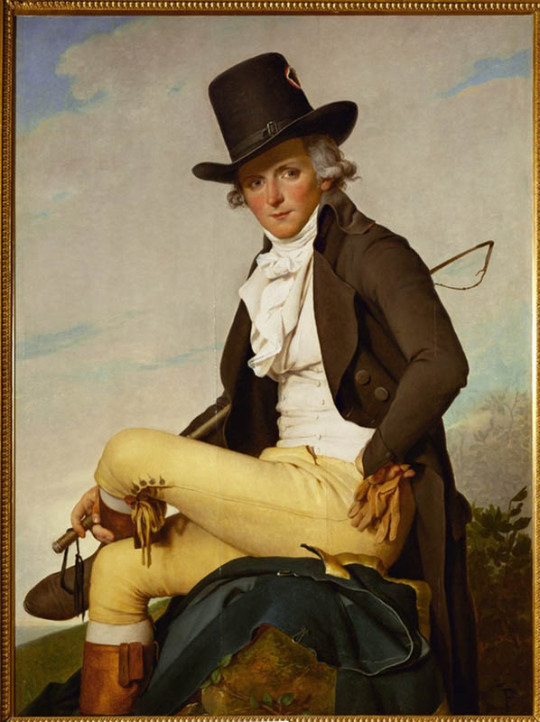
This is a French painting of a wealthy Frenchman, but he's wearing the English 'Corinthian' style. It was painted in 1795, so this would have been the very cutting edge of fashion in England in 1793, and the fabrics and colors look right at home in Revolutionary Paris. (He's wearing the cockade on his hat, btw.)
Look at all that angelic white! The buttery almond of the buckskin breeches, the golden kidskin gloves, the rich tan of the riding boots! The blue of the greatcoat! All colors we know Aziraphale prefers!
And yet this is what Aziraphale chooses:

We know from the entire rest of the show how very particular about his clothes Aziraphale is. And yet 150 years before he (accidentally) admits in words that he's Crowley's friend, Aziraphale wears Crowley's colors to take him to lunch to say thank you for a rescue.
When we decide whether a character's speech or action is equivocation, one of the things we check is whether equivocation (and deception generally) is something that character does elsewhere in the text, which, with Aziraphale, hahahahaha, DUH. He's already using equivocation in this scene.
The lunch date itself is equivocation on Aziraphale's part. Aziraphale tries to thank Crowley for the rescue, but Crowley says,
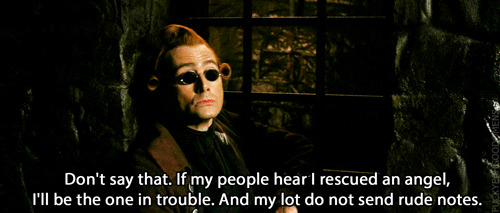
So Aziraphale says,

No more words like "thanks" or "rescue" used, but a couple hours of good food and drink and conversation, Aziraphale hopes, will express the gratitude toward Crowley it's not safe to speak aloud. With this, Crowley and Aziraphale explicitly establish that they are equivocating for each other's safety and using coded communication--immediately before Aziraphale changes into Crowley's colors.
So yes, Aziraphale may well copy the executioner's clothes. But consider: When a character who can't speak or act openly says or does something that has two or more possible meanings, this can be read as equivocation.
We don't get a face reaction from Crowley about Aziraphale's new 'fit, so we can't be sure how he feels about this. But this whole scene is, even on its surface, about 1) the meaning clothes transmit to a viewer ("Oh good Lord," says Aziraphale when he sees what Crowley's wearing) and 2) how to show gratitude and appreciation when you can't speak of them openly. And we know Crowley notices clothing and clothing colors, because look at what he wears, like, ever. So it's very reasonable to presume he notices Aziraphale wearing his colors, and it fits well with both the rest of Crowley's actions in this scene and with his being very hurt and angry when Aziraphale later characterizes their interactions as "fraternizing."
Right, so we've covered what's going on with the husbands' clothes, and we've looked at two examples of equivocation on Aziraphale's part, viz., lunch and his change of colors. (Here's an example of equivocation on Crowley's part as well.) Now let's look at that super interesting thing Crowley says about Aziraphale's first outfit.
Here's the line:
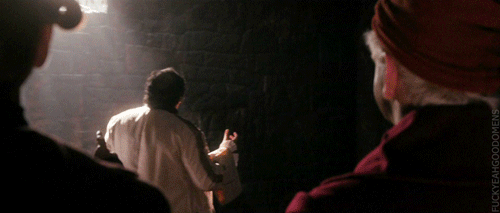
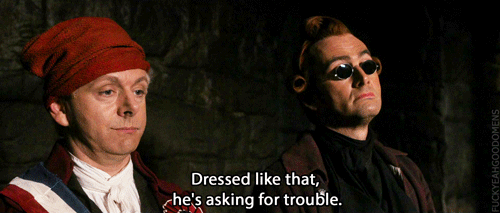
Crowley follows up here on earlier lines in which he teases Aziraphale for coming to Reign-of-Terror Paris for crepes: "Dressed like that?" meaning Aziraphale was guaranteed to get arrested dressed like an aristocrat. The top layer of equivocation is always an innocuous meaning: the plausible deniability meant for the hostile/unsafe listeners. That's Meaning 1.
But "Dressed like that, s/he's asking for trouble" means two other things, too. It's a veeerrrrry familiar phrase, isn't it? We've all heard that arrangement of words in that order before. It's used when people think someone (usually but not always a woman) is dressed to invite sexual attention.
How do we know we're supposed to take this modern meaning from this phrase? This is how:

We have learned in literally the previous sentence to this one that rain has not been invented yet. The only two humans in existence have just left the Garden. Balloons definitely do not exist yet, humans couldn't tell you what lead is, and yet this is a phrase Crowley uses and Aziraphale understands. This tells us, the audience, in the very first line of the very first scene with these characters, that their speech is anachronistic and modern, and that we are to understand their phrasing in its contemporary sense.
So. When Crowley says "Dressed like that, he was asking for trouble" in 1793, we should read that in the context of the scene and in the senses the phrase carries to us today.
And since Crowley is using a phrase that means the executioner is dressed to invite sexual attention, and the executioner is wearing clothes identical to Aziraphale's, then Crowley is necessarily telling Aziraphale that when Aziraphale was wearing those clothes--those frilly, effete, unfashionable-for-decades clothes that nobody else likes and the French now murder people for wearing--that was, in Crowley's view...provocatively sexy. Meaning 2.
"Dressed like that, s/he was asking for trouble" is also what people say to justify violence, especially sexual violence against women and queerphobic attacks against men perceived as gay or just 'insufficiently' 'masculine'. In fact justifying assault is likely the most common way this phrase is used today by a wide margin. Meaning 3.
Crowley's joke isn't even really a joke in this sense; it's a vicious barb. And, because it must, it sounds like it's at Aziraphale's expense: You wore the wrong clothes, you weren't careful enough to guard yourself against the men who want to do you harm, so you deserved the trouble you got. Meaning 1.
Except remember: Crowley is also dressed for trouble. And Aziraphale is aware of this. Crowley's 'fit would be almost as offensive to the Revolutionary French of 1793 as Aziraphale's Rococo pastels, and probably just as likely to get him arrested and murdered by the state if he weren't making letting Aziraphale keep him safe by wearing the cockade and the silly hat. Crowley's not saying anything about Aziraphale here that he's not also saying about himself; and as we know from Aziraphale's initial "Oh good Lord" when he turns around and sees Crowley's black and red half-mourning (with extra black and gobs of silver), Aziraphale knows it.
Then why the rapey joke, Crowley?
This is fucking why:
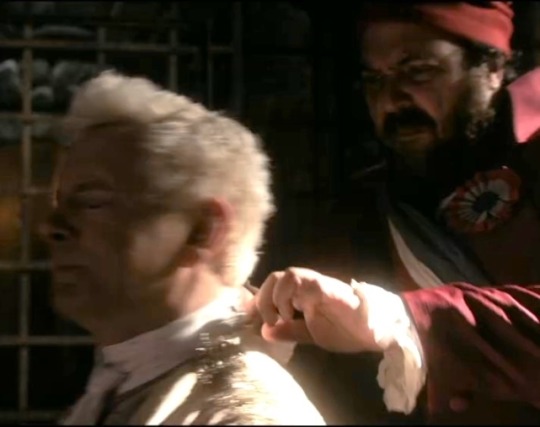
Crowley rocks up at the Bastille just in time to witness some grubby fucker assault his friend. Assault the person Crowley will greet 15 seconds after this as angel.
Crowley's first act after freeing Aziraphale is to send this dude to his death. Nope! Aziraphale is the one who arranges to have the executioner killed in the clothes he would have killed Aziraphale for wearing. He takes Jean-Claude's ability to speak (but not to make sounds, interestingly! Jean-Claude can still whimper, Jean-Claude can still cry!) so the executioner can't tell anyone about the 'mixup.' It's unclear which of them blocks the executioner's power of speech. The vicious joke about assault in Meaning 3 isn't at Aziraphale's expense at all. It's not You wore the wrong clothes, so you deserved the trouble you got. It's If this guy thinks you deserve trouble for wearing the wrong clothes, he can eat his own rules.
And that's the other piece of evidence that, along with Crowley's ensemble, shows us the audience and Aziraphale which meanings Crowley intends with his equivocation. Meaning 1 is cancelled out by Crowley's clothes. That leaves Meanings 2 and 3.
Crowley and Aziraphale share clothes as a common interest. They don't have the same style, but they're both aware of current fashions, and Heaven and Hell aren't. You can't tell me Hastur or Uriel would recognize the significance of Crowley saying "Dressed like that, he's asking for trouble" about someone else while wearing black stockings and cravat and waistcoat himself. And that means Anything the husbands communicate to each other through clothing choices goes undetected by their masters.
SO. With all this in mind, let's go through the 1793 scene again and look at what their clothes help them say without words.
Concluded in Part 2!
#good omens#good omens 2#good omens s2#good omens costumes#good omens fan theory#good omens meta#good omens analysis#aziracrow#azcrow#ineffable husbands#aziraphale x crowley#azicrow#good omens 1793#good omens 1984#good omens clothes and equivocation
548 notes
·
View notes
Text
The early 19th century sure was something for our boys (gn). They were taking things at a FAST pace. (If, of course, you’re immortal and need to layer everything under 6 layers of deniability).
Whatever you do, don’t think about how in 1793 Crowley rescued Aziraphale and then they got lunch, in 1800 he brought chocolates to the bookshop then saved Aziraphale from a heavenly promotion, then in 1827 they went on a date to a cemetery in Edinburgh(prime date spot at the time esp for non-trad couples) and Crowley seemed to be having the time of his life.
Then especially don’t think about Crowley getting lightning-sanded down to Hell and showing up 35 years later in a much grumpier mood and with a request for Holy Water as “insurance”.
And don’t think about the context of their last interaction being attempted suicide by poison drink after a partner was lost… no wonder Aziraphale didn’t take the request well and they fought. No wonder Crowley was offended by fraternizing - they’d been way beyond that. Nope, don’t think about any of that.
#I know you can take A’s journal entry in a way that means they met up sooner#but I like this interpretation#lol the whole thing is such a departure from book omens#when Crowley slept thru the 19th century#from a doylist perspective it’s almost certainly to be able to dress the lads in amazing costumes#I approve#the 19th century#good omens#good omens headcanons#good omens s2#ineffable husbands#crowley#aziraphale#good omens 2#good omens meta#aziracrow#a duck talks
424 notes
·
View notes
Text
Notes on Crowley's Red Highlights


I've just noticed Crowley's single red highlight in S2 thanks to this image. Crowley doesn't seem to have any highlights in his hair since it's done only with a red hair dye, save for one strand. (Second image by @fuckyeahgoodomens)
It's not a shadow or the lighting, it's a highlight and it's been there all along, but it always looks much duller in the episodes. For instance, some episode 6 screenshots:



And there it is, on the poster too. I think it was done with three different but adjacent foils that blend into a single thick highlight.
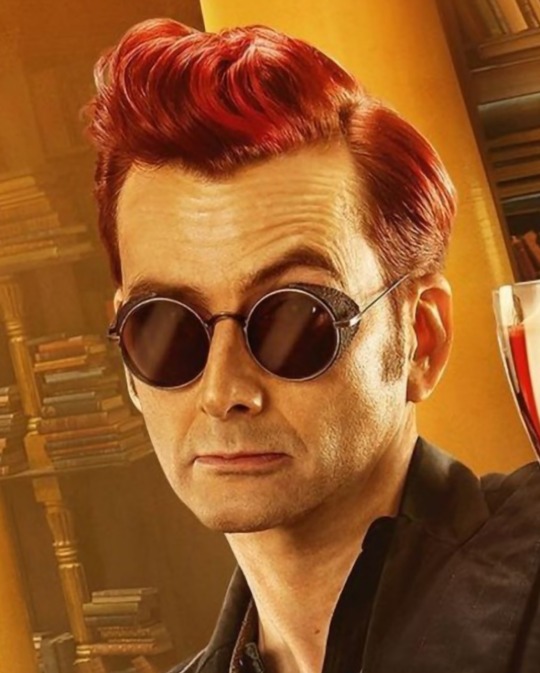
But look who's got some highlights of her own.


They are quite identical too, in both colour and thickness. Coincidence? A parallel? Or is she simply imitating Crowley?
Why add the single highlight in the first place?
I forgot to mention that Nina's also got the same highlights. See what they did there?

#good omens#good omens season 2#neil gaiman#crowley#good omens theory#good omens meta#good omens analysis#good omens costumes#shax good omens#ineffable partners#ineffable husbands#david tennant#crowley hair#good omens nina
284 notes
·
View notes
Text
I find Aziraphale’s tartan really interesting in the way it reacts to light
In a darker setting the blue stands out

but in a lighter setting it’s the red that stands out

reminds me of 3D glasses
#on other rewatch#sorry for the shit screenshots#honestly most of the time it looks like various shades of tan#good omens#good omens 2#good ineffable omens#good omens meta#aziraphale#a.z. fell#aziraphale’s tartan#good omens costumes#how does the costume department do it#beautiful bastards
243 notes
·
View notes
Text
Let's talk costuming: Angelic Robes and The Unreliable Narrator
It's two am, I have to be up at six, but this has been fermenting in the back of my head for the past five hours I've spent doing homework and if I don't get it out I shan't sleep.

The costumes we see representing angelic character in Season Two are VASTLY different from those we see in Season One. (See my post on Aziraphale's Job Robe for an in-depth art history analysis of this individual costume piece.) In season one, the angelic flashback clothing we see is rather humble and uncomplicated. As all things in this show, this serves a very important narrative purpose.

Let's first compare these gorgeous gorgeous girls to their S1 counterparts, shall we?

Just look at the collar on that robe! In S1, we're introduced to Aziraphale in a very plain tunic-style robe with an unfinished neckline. Aside from a slight gold decoration and draping on the shoulders, this could easily be mistaken for rather primitive human garb. S2, by comparison, introduces angelic costume as non-ostentatious but still refined with a gold-trimmed gathered neckline and wide sleeves. The fabric itself, on a textile level, is much finer and softer. Overall, the robes give an air of innocence and angelic purity that is lacking from Aziraphale's S1 'fit. Let's look at another example:

Their Rome costumes are strewn with so many incredible details (check out this incredible post from 2019) but they still retain a bit of that historical ruggedness. Same for these:

The argument could be made for pure historical compliance, sure, but to claim a lack of anachronisms in this show would be a flat-out lie. No, S1 Crowley and Aziraphale are very distinctively human in their dress. The cloth has a wider weave, the ornamentation is minimal, all around it serves to highlight their fitting-in with humans and the humanization of their characters. They're 'going native,' as it were, no doubt about it.
So why, in S2, is Aziraphale suddenly showing up looking like he just popped out of a renaissance painter's wet dream?

Simple. Suddenly, Aziraphale isn't an angel among humans acting human, he's an angel being an angel doing angel things. We get to see the rest of the heaven gang in full angelic decadence as well, a bold departure from the starkness of 'modern' heaven. If this is, as many of you lovely folk have speculated, a series of flashbacks from Aziraphale's memory, the design choices designate very clearly Aziraphale's perception of himself as an angel. A perception which, mind you, would likely be influenced by later human ideas of angelic and heavenly aesthetics. As an unreliable narrator, Aziraphale is showing us not his actual wardrobe as an angelic being but his perception of his past self.
Crowley, too, is affected by this shift in dress. Bildad the Shuhite is everything S1 flashback Crowley is not: fashion-forward, smooth-talking, and impeccably well-dressed. We've got three different fabric textures (that's three times as many as any of his biblical S1 robing) and a definable silhouette. He's practically a fashionista.

If this were all taken as an objective narrative, the shift back to billowing-void peasant Crowley at Golgotha, where we next see her chronologically, would be strange to say the least.
So why is the costuming of the S2 pre-modern flashbacks so much more elaborate? There's three possibilities I can imagine for a change in costume design for any show:
Budget: this is highly unlikely an instant rule-out for me. I've seen what costumers can do on a shoestring budget, and besides the later period costumes make this demonstrably false.
Change in production design team: Technically possible, yes, but if there's one thing Good Omens does well between seasons it's continuity. I mean, they burned the fucking bookshop and then hand-painted tiles to recreate it exactly for the second season. This is not Harry Potter. This isn't it.
An intentional design: Everything, and I mean everything, in this show is intentional. While not everything the wardrobe team does is easily decodable (see Crowley's shapeshifting sunglasses) we've got a pretty comfortable bit of time to figure such things out. This is the only option that makes a lick of sense.
Wonderful, so we've established that this is a narrative choice.
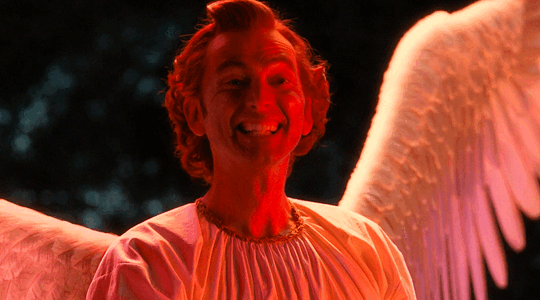
So if it's a narrative choice, and it's distinct from the stylistic choices of Season One, then someone is lying to us. Or rather, we have an unreliable narrator somewhere along the way.
Most of the buzz on ye olde tumblr focuses on the idea of Aziraphale as narrator and memory-holder for S2, and that would certainly make sense from both a story and design. Of course he would see Angel Crowley as adorable and innocent and angelic (the hair is not helping his case either omg I love her), and of course he would see himself as grandly, exaggeratedly, almost dissonantly angelic at the major turning point in his faith.
If Crowley is narrating, then it calls into question why he would choose to remember himself this way. It holds a sort of nostalgic sadness, a memory of a joyful innocence permanently lost to God's cruelty. When we see Aziraphale in angelic splendor later, we're reminded again of what Crowley has lost. It echoes the aesthetic of his former angel self, the gathering and gold trim and bright white fabric, but also introduces a much more elaborate silhouette that reflects the shift toward heaven's new high-and-mighty attitude.
Finally, I'd like to point out that by contrast Season One focuses heavily on themes of humanity rather than ethereality. Narrated by God, no less, who probably has thoughts on their assimilation. While I think we can assume God to be a more reliable narrator than Crowley or Aziraphale, it's not out of the question that She would have her own story to spin about our Ineffable Idiots' shared history.

Ultimately, I think it's safe to say that whatever's going on in costume design is a Clue to the story we're being told in S2 and the one we will be told in S3.
#I would commit unspeakable crimes to work wardrobe for this show#just let me sew on some buttons and I'll be happy as a clam#good omens#good omens 2#good omens season 2#good omens meta#good omens analysis#good omens costumes#costume design#ineffable husbands#unreliable narrators#angel crowley#go2#neil gaiman
203 notes
·
View notes
Text
Metatron's Tie
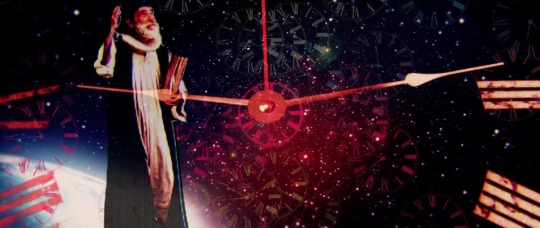
**Update: check the reblogs. There's a clear picture that shows the tie pattern as flowers. So, there goes my theory. Whomp whomp. Easy come, easy go, as Freddie says. @archangelween @drconstellation
People, I have been trying to get a good look at the Metatron's ding dang neck tie since September to determine what those little blue symbols are. Because, like everything in the Good Omens universe, I believe it's been put there for a reason. I also believe that God has no idea what she's doing, which is why she hired Neil Gaiman to run things for a few decades.
Despite being a so-called agent of Heaven, the Metatron's costume is coded as demonic, from his dark topcoat to the black stripes on his white shirt. The item I find most fascinating, however, is his tie. And this is probably in large part because I've had so much difficulty seeing the subtle blue pattern upon it and that has made my brain itch and made me hyperfixate. As one does.
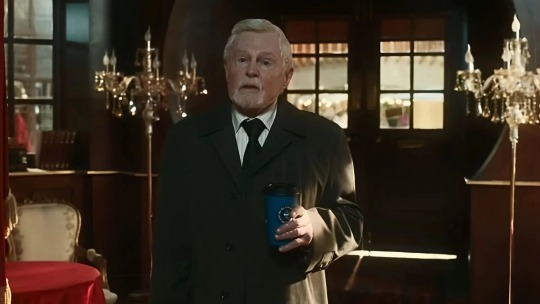
I think I may have figured out the design, and it complicates all my Metatron theories, but here we go. The Metatron's tie is black, featuring a repeated small bright blue symbol throughout. I've guessed it could be a star or a planet. A cryptic sigil or maybe something to do with the coffee (I'm not a coffee-theory person, though, for the record.) I don't know what it is (well, maybe I do now, and I promise we'll get there in time...I'm a demon of my word), but I do know that it's important.
All the angels have references to their angelic status concealed within their costumes.

Michael is the watcher. She is the one who, in Saturday Morning Funtime, delivers surveillance photos to Gabriel. To reflect this, Michael wears a gold ring featuring several small pearls that symbolize eyes. She is ever-vigilant (hyper-vigilant, ya might say), and even has a contact in Hell (Dagon) to broaden her scope of observation. The placement of the ring in the pinky is also significant. A good watcher mustn't themselves be observed, so Michael, in her role as observer must slip under the radar. This corresponds to the pinky finger being small and quite literally underhanded, as in at the bottom of the hand.
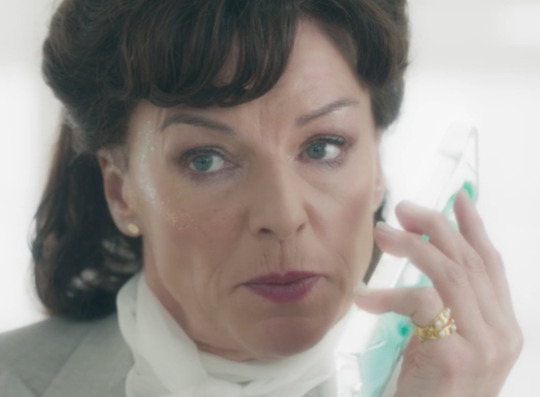
Uriel's ring is a silver star, worn on her/their index finger, the digit associated with authority. (We call it the index finger because we use it to sort and catalog, creating meaning and order.) Uriel certainly commands authority, both in their overall calm and assured demeanor, and also in their actions. It is she who physically confronts Aziraphale prior to the S1 No-pocalypse, easily inspiring fear in the Principality. As for the symbol of the star, I believe it is a reference to modern Angelography (I might have made up that word, but I think you know what I'm talking about) which usually describes Uriel as a sun, star, or the flame of the Almighty.

Sandalphon's symbology is two-fold: a thick gold pinky ring featuring a pair of circles (kind of looks like a lego brick, to be perfectly fair) and that small gold grill he wears on his front teeth. Both these items are the most elaborate pieces of angelic adornment that we see. Sandalphon's overall aesthetic is much warmer than the other angels', leaning toward caramel and tan rather than dove gray. He's a bit of an odd ball in the host of Archangels and stands out based on his wardrobe choices alone. He's also the only Archangel not to return in S2. I don't want to make too much of this, because there are many in-universe reasons why we may not see Sandalphon again. However, in Judeo-Christian scripture, Sandalphon is closely joined with...wait for it...the Metatron, with apocryphal texts describing him as Enoch's (the Metatron's pre-angelic human name) twin brother. I take this with a hefty spoon of salt, though, since Neil definitely plays loosey-goosey with these dogmas and even the scriptures themselves are a veritable soup of contradiction. (The Bible is not a static or universally canonical text, and Hebrew scriptures, outside the Tanakh are a web of activity and debate as to what is accurate. I'm not here for the arguments today; this is not my Bat Mitzvah.)
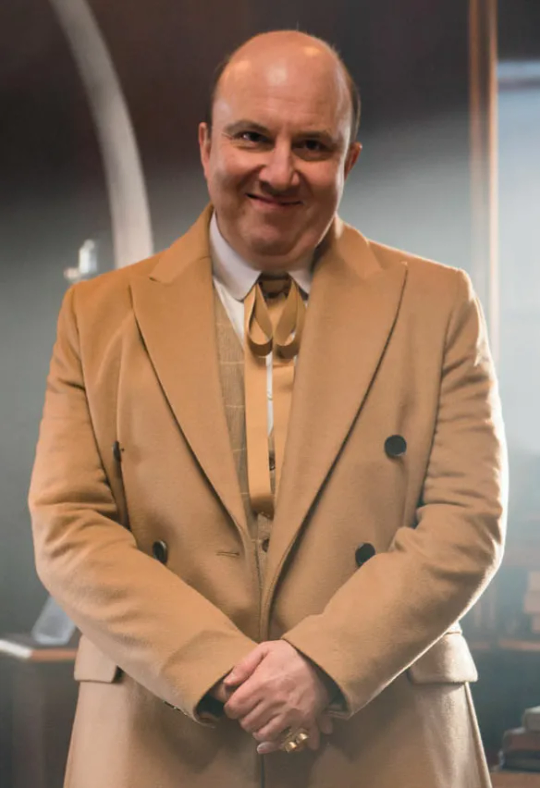
Finally, we have Gabriel, the only Archangel who doesn't wear a ring. He does, however, wear a watch. I have two thoughts about the watch. First, clocks are thematically relevant in the Good Omens universe. From the grandfather clock in the bookshop to Crowley's elaborate wristwatch (which he has in both show and book) to the opening sequence of S1, which has far too many clock faces to count. So there's that. But holding time in one's hand (or on one's wrist) is a powerful metaphor that illustrates control and higher power. To possess a clock is to command time and space which are essentially inseparable. As the Supreme Archangel, Gabriel is nearly the top-ranking being in the universe (for a time, at least...see what I did there? pathetic laughter) and his wristwatch demonstrates this point.

If you're still with me, you're doing great. Good job.
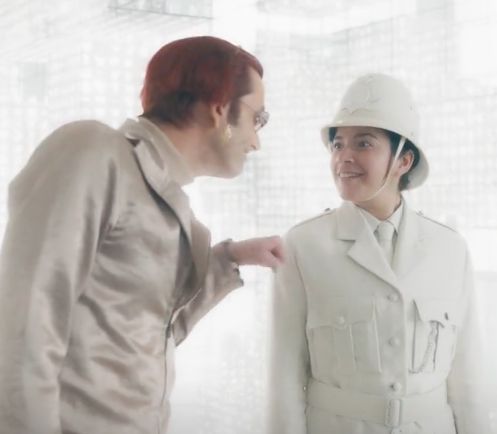
We've got to see how important the Archangels' symbology is to their characters, I think, to really understand why the sigils on the Metatron's tie matter. So, finally to the point. Dolphins. Thanks for coming to my TED Talk.

To move forward, we'll need to call upon my old friend, the Tarot deck. Cards, in general, and Tarot, in particular, play a marked role in the GO universe. The Almighty Herself addresses the viewer in the opening lines of the show, "God does not play dice with the universe; I play an ineffable game of my own devising. For everyone else, it's like playing poker in a pitch-dark room, for infinite stakes, with a Dealer who won't tell you the rules, and who smiles all the time." As God speaks, cards appear on screen, and some of those are from the Rider Waite Tarot deck. One specific card that caught my eye in this montage is "Judgement."
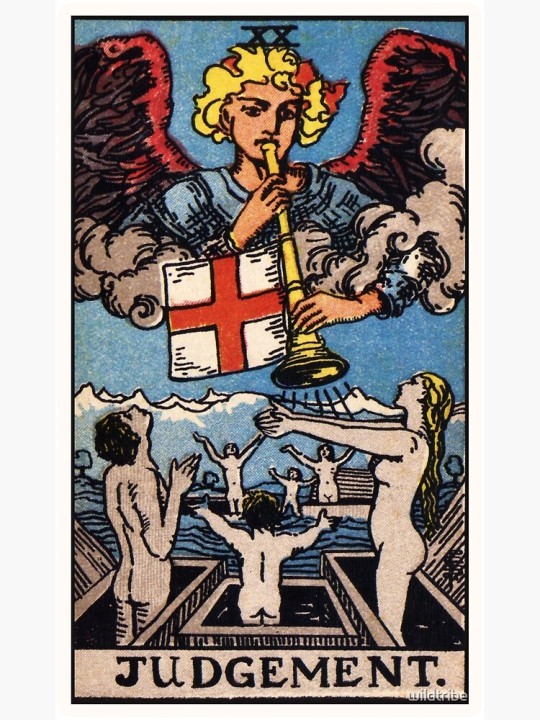
This card features an angel blasting a trumpet and waking the dead from their graves on the Day of Judgement. The angel on the card is not named, as such. It's usually assumed to be Raphael, as he is the angel who is prophesied to call and raise all souls on this day. However, I've found other references naming the angel as either Gabriel or the Metatron. Now, I don't want to get overly carried away here, but in the context of Good Omens, reading the Judgement card with the Metatron as the angel pictured may actually make a lot of sense, and clarify the sigils on the Metabutt's tie. The Metatron postures himself as the Voice of God--the Mouthpiece of the Almighty. Kinda like a trumpet, yes?

Now look at the flag on the angel's trumpet. That's called St. George's Cross and it's a very prevalent European Christian symbol dating back to the Middle Ages. Like many images in the Tarot, it's a heraldic emblem that has meaning outside the deck, often associated with bravery and military might. It continues to be used in military iconography into the present day. The Judgement that the angel heralds is not peaceful. It's a call to war. The righteous will be gathered to Heaven and the wicked will be destroyed--a repeat of the first Great War in which Satan and the demons were cast into Hell. In the narrative of Good Omens, this war will bring about the end of time, the end of the world, and the beginning of eternity (hope ya'll like The Sound of Music.)

Kids (human and goat, alike) I think those little blue sigils on the Metatron's tie are Saint George's Cross. (I'm so sorry this is so small and hard to see. Now you know my pain.)

In the Final Fifteen, the Metatron speaks briefly about the Second Coming, which is a reference to Saint John of Patmos' prophecies--you might know them as the Book of Revelation. Some Christians interpret Revelation as an upcoming final judgement for humanity. And it seems, based on in-universe exposition, certain characters view these prophecies in a similar light. In the reverse body-swap at the end of S1, Crowley suggests that the averted Apocalypse was not the end of the conflict. "If you ask me," he says, "Both sides are gonna' use this as breathing space before the Big One. [...] For my money, the really Big One is all of us against all of them." And with the Metatron acting as the Mouthpiece of God, that "Big One," that Day of Judgement, if you will, may well be nigh.
I think the Metatron sees himself as the angel who rings out the Final Judgement. He is the Voice of God, after all. But here is a worrying thought. How little he would need to shift perspective to view himself as the Word of God, as well. The Gospel of John opens, "In the beginning was the Word and the Word was with God and the Word was God. The Same was in the beginning with God." The Word of God is an epithet for Jesus. The same Jesus whose Second Coming the angel of judgement is meant to announce. So what if the Metatron just plans to consolidate these roles for himself: the heralding angel and the Second Coming rolled into one. He would become Judgement Incarnate, supplanting the Almighty once and for all. And for my money, that sounds just like what a demon would like to do.
***I'm updating because several readers have pointed out that it seems like I'm saying Metatron=Demon because Demon=Bad. Thank you for bringing this to my attention--it makes me a better communicator. I can see where it's coming from. It's not my intention. Consider this meta sort of an extension of my "Metatron is the Murder Hornet" meta, which I'll link with the tags if you're interested.
Just wanted to clarify that I think at its heart, Good Omens is thematically about rejecting the dichotomy of good and evil and embracing the messy gray space that is reality.
When I call Metaboob a demon, it's not because I think demons are evil, it's because I think he's the hornet in the beehive and we've seen that demons need an angelic escort (Crowley and Muriel) to access Heaven.
TL;DR Angels are not the good guys. Demons are not the bad guys. Good Omens is NOT about that at all.
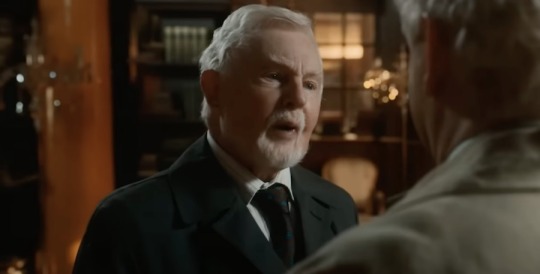
#good omens#the metatron#metatron#good omens 2#go metas#tarot#archangels#archangel fucking gabriel#archangel gabriel#archangel uriel#archangel michael#archangel sandalphon#good omens costumes#go costumes#youtube#metatron is a demon
176 notes
·
View notes
Text
Maggie’s pendants and good omens
Yes, you’ve read it right. This post is going to deal with some literal good omens, not just title drop! But first things first, let’s take a closer look at the topic of this analysis.


A toucan
The top necklace is a lovely design involving a crowned toucan — believed to be a messenger of gods able to travel between the spiritual and the physical world, often associated with rain and rainbow (a Christian symbol of divine love, grace, and mercy, a reminder of the covenant between God and humanity to spare the latter from future trials like the Flood) — encircled by a gold band (a symbol of infinity, eternal love and promise) spun by a small butterfly (a symbol of transformation, hope, and rebirth). All three symbols combined seem to deliver a divine message of hope for rebirth, possibly resurrection, and the eternal life. Very fitting in the context of the Second Coming.
The fact that toucans were revered by the native South Americans as rainbringers strengthens the symbolic meaning of another type of bird we can spot on Maggie’s clothes in the very first episode, as her character introduction — a swallow. Swallows flying low are also believed to be harbingers of rain and bad weather. If you see one close to Earth or a building, it means that there’s a storm — or a certain biblical tempest — on the horizon.
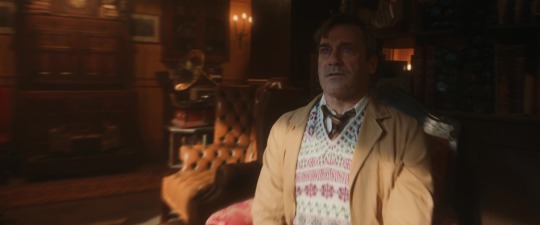
In Ancient Greece and Rome swallows were representing Aphrodite, goddess of love. In Christianity they were considered to be of God and symbolized hope, awakening, and revival of life as messengers of spring and protectors from winter colds. Also helped Jesus on the Cross — according to a Christian legend, a group of swallows was supposed to take out the thorns from the Crown of Thorns and alleviate His Passion on the Cross. Humans banding together in the name of good have been a big theme in the series ever since The Them made an appearance, and from what we already know about the unpublished Good Omens sequel, we can assume that Jesus is going to take the spotlight in the upcoming season.
Maggie definitely attracts sudden inexplicable weather changes, like a thunderstorm with weirdly localized lightning strikes or a sudden downpour. And we’re still waiting for some vavooming (and the following happy ending) to happen in S3.

A heart with an eye
Now, the more nuanced clue hidden in the bottom necklace. I know that some of us were trying to tackle the concept of Maggie’s eye in a heart pendant suggesting her Masonic connotations, but this symbol (or the Eye of Providence in general) isn’t strictly Masonic, it isn’t even limited only to Judeo-Christian art. And while it is used a lot in Christian iconography, we should focus on a very specific example of it already referenced in the show.
Buckle up, we’re making a parachute dive into S1.
It seems like our old friend, Agnes Nutter, still has our backs.

Prophecy 4020:
Let the wheel of fate turne, let harts enjoin, there are othere fyres than mine; when the whirl wynd whirls, reach oute one to another.
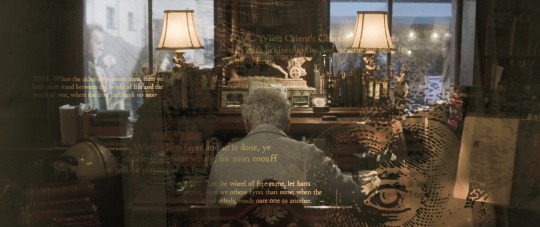
If you look closely at the bottom right corner of this frame, you will see that as an illustration for the above prophecy the production team chose a 1611 engraving titled The Minde should have a fixed Eye On Objects, that are plac’d on High first found in Gabriel Rollenhagen’s Nucleus emblematum selectissimorum.
In 1635 it was published in A Collection of Emblemes, Ancient and Moderne Quickened With Metrical Illustrations, both Morall and Divine, Etc by George Wither with the accompanying hymn:

A Heart, which bore the figure of an Eye
Wide open to the Sunne; by some, was us'd,
When in an Emblem, they would signifie
A Minde, which on Celestiall Matters mus'd:
Implying, by the same, that there is nought
Which in this lower Orbe, our Eyes can see,
So fit an Object for a manly thought,
As those things, which in Heav'n above us be.
God, gave Mankinde (above all other Creatures)
A lovely Forme, and upward-looking Eye,
(Among the rest of his peculiar Features)
That he might lift his Countenance on high:
And (having view'd the Beauty, which appeares
Within the outward Sights circumference)
That he might elevate above the Sphæres,
The piercing Eye, of his Intelligence.
Then, higher, and still higher strive to raise
His Contemplations Eyes, till they ascend
To gaine a glimpse of those eternall Rayes,
To which all undepraved Spirits tend.
For, 'tis the proper nature of the Minde
(Till fleshly Thoughts corrupt it) to despise
Those Lusts whereto the Body stands inclin'd;
And labour alwayes, upward to arise.
Some, therefore, thought those Goblins which appeare
To haunt old Graves and Tombes, are Soules of such,
Who to these loathsome places doomed were,
Because, they doted on the Flesh too much.
But, sure we are, well-minded Men shall goe
To live above, when others bide below.
And hey, guess what 4020, i.e., the number of the prophecy, symbolizes in Strong’s Concordance? Periergazomai, a Greek word meaning “to waste one's labor about something” — to meddle, going beyond proper boundaries (where a person doesn't belong); to fixate on what others are doing, instead of doing what the person himself is supposed to do.
It appears only once in the Bible:
2 Thessalonians 3:11: We hear that some among you are idle and disruptive. They are not busy; they are busybodies. Such people we command and urge in the Lord Jesus Christ to settle down and earn the food they eat. And as for you, brothers and sisters, never tire of doing what is good.
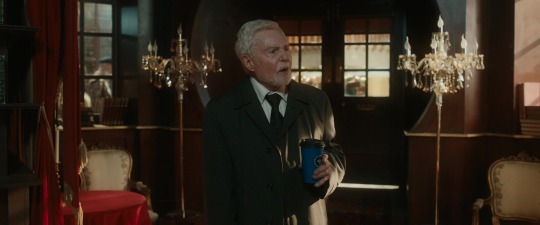
To make things slightly more interesting, in the Hebrew version of Strong’s Concordance 4020 has another meaning — migbaloth, meaning “twisted things, i.e. cords”. Which doesn’t make much sense until we read the actual passage:
Exodus 28:24 and two chains of pure gold, twisted like cords; and you shall attach the corded chains to the settings.
And compare it to the most recent post on the topic published directly by Word of God:

What if all these clues didn’t apply to Maggie and Nina, but Aziraphale and Crowley instead? What if Maggie served as a messenger — consciously or not — just like the toucan, delivering the prophecy to those who need it most?
“When the tempest comes and darkness and great storms, and the dead will leave their graves and walk the Earth once more and there will be great lamentations for the end is near, don’t lose hope, hold hands and look up.”

Basically what Aziraphale and Crowley already did when they performed the 25 Lazarii miracle, only with no interference from Gabriel this time around.
And, if both Strong’s Concordance and Maggie’s personal addition to her second pendant are to be believed, with a wedding band somehow involved in the process.
#everything has a meaning#the invisible and unbreakable line that joins Crowley and Aziraphale#two chains of pure gold twisted like cords#never tire of doing what is good#don’t lose hope#hold hands and look up#the good omens crew is unhinged#good omens props#good omens costumes#the nice and accurate prophecies of agnes nutter#agnes nutter#good omens#maggie service#good omens meta#good omens analysis#strong’s concordance#yuri is doing her thing#ineffable husbands#wedding bands
76 notes
·
View notes
Text
Think you've never seen Witchfinder Major Pulsifer before? Vincent Price would like you to think again.

Good Omen's S1 (2019)


Witchfinder General (1968)
#good omens meta#art director talks good omens#go meta#good omens#good omens prime#good omens analysis#witchfinder general#vincent price#go1#good omens costume meta
46 notes
·
View notes
Text
I noticed something on a rewatch about the arc of Aziraphale's coat. When it gets hit by that paintball, he says, "I've kept this in tip-top condition for over 180 years."

So, since 1839. 20-odd years before the fight / breakup in St. James's Park, which is the earliest we see it.
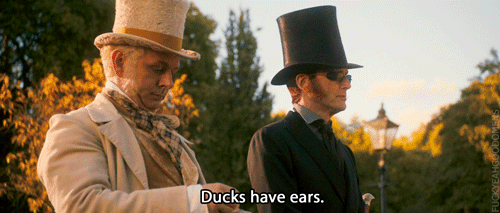
But wait, I says to myself, he wasn't wearing that coat in the 1940s Blitz scene in the church. He wears a different outer coat in that scene, one that looks new, made of a material that's stiffer and slightly shiny.
[Of course, one typically wears nicer and more uncomfortable clothes to one's wedding, and Crowley also looks very sharp and more buttoned-up than his typical look in this scene, but that's neither here nor there.]

After that, after Aziraphale realizes Crowley still cares for him despite their fight, and realizes he loves Crowley too, he switches back to the 1800s coat for good. When he appears in the Bentley in the 60s, he's back in the old coat, and he wears it every scene after that. [He does have that other gray cardigan-like jacket, but that's for relaxing in the bookshop only.]
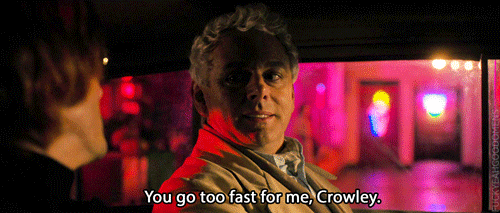
In that argument in the park, he feels such a strong need to push Crowley away, for Crowley's own protection. (Every other resistance to collaboration, from the Globe onward, his argument is that *Crowley* would be in danger if they were found out; only in the park fight does he argue that *he* might be in danger. He's saying to Crowley that they need distance to protect him, Aziraphale, because even in his agitation he knows that Crowley's #1 motivator is protecting Aziraphale). Maybe after that, he tries to move on, switch to a modern new coat. And maybe Crowley coming for him again in the church lets him know it's okay to be himself again, to go as slow as he needs to, because Crowley will always come back for him.
~~~
AND ANOTHER THING
has to do with lapels.
Aziraphale's Blitz coat looks much more similar to the jackets worn by the other angels. Take a look at Michael and Uriel's jackets here. They are stiff and have that sheen to them, and the lapels point up.
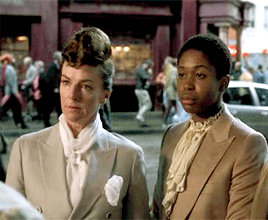
Like Aziraphale's Blitz jacket.
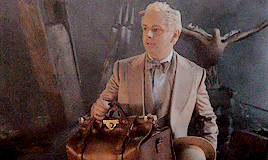
Compare that to the lapels on his trusty old coat. This coat is soft, just like Az. And the lapels point down.

Okay, okay, so what about demons? We know they deliberately did the miracle gestures with Aziraphale's snap pulling something down from Heaven and Crowley's pulling something up from Hell. If the angels have upward-pointing lapels, it would make sense for demons to have downward-pointing lapels, if my theory is going to hold.

Yup, that checks out. Hastur and Ligur have floppy sad ugly lapels that droop down toward Hell.
So, the final piece to this puzzle.... how about Crowley's lapels?

Outrageously spiky upwards-pointing lapels. Because of course. I rest my case.
~~~
[Okay, a couple of caveats. (1) I'm not an expert on fashion or clothes, so I welcome corrections and additions. (2) It's possible that Az's soft, favorite jacket is a summer jacket and the stiffer one he wears in the Blitz is a winter jacket. Not clear what season it is in that scene. (3) Stay tuned for a follow-up post about Gabriel and Beelzebub's lapels. (4) Also, I haven't compared any of the other outfits throughout history, and I only looked at Crowley's 2019 jacket. (5) Sorry if the gifs are weird, I don't really know what I'm doing. (6) Also sorry if this has already been discussed; I try to only post stuff that I haven't seen elsewhere, but I know I'm late to this party!]
#good omens#good omens meta#the symbolic resonance of lapels#costume design#heaven and hell#aziraphale#crowley#ineffable husbands#long post#meta
1K notes
·
View notes
Text
Mr Brown's Ensemble at the Ball
I think this officially marks the moment I've moved from obsessed to completely unhinged. It was only a matter of time. Welcome one and all! Here I loose my mind over the fact that Mr Brown is seen revived in line for the coffee shop wearing his outfit from the Dirty Donkey, NOT his outfit from the ball. But to back up, let's start here:

There's already been theories about how Mr Brown's outfit at the Whickber’s Street's Ballroom Meeting resembles Crowley's from when they met at the pub because Mr Brown has a pash on Aziraphale (also infamously blogged about here). Just as a reminder (in case anyone could forget) I'm referring to this outfit...
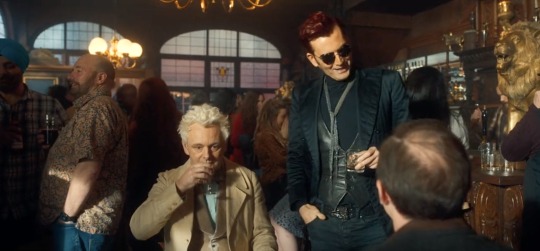
And the fact that Mr Brown shows up at the ball in a turtleneck and vest and jacket much like we see above, however with the vest and jacket in tartan that looks suspiciously similar to dear Mr Fell's bowtie.
I had headcanoned that Mr Brown dressed himself like this at the ball on purpose to catch Aziraphale's eye, but upon latest rewatch I caught this:
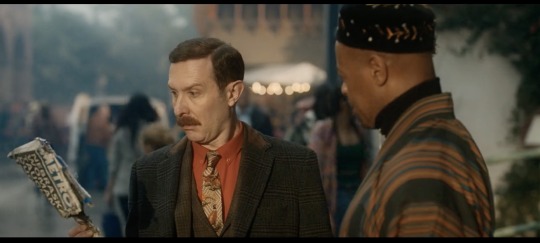
The next morning, Crowley brings Mr Brown back wearing the exact same outfit that he was wearing from the other day at the Dirty Donkey:
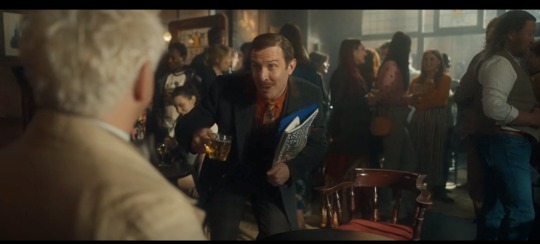
Aaaand this is where I completely lose the last shred of my sanity to this show. Does this mean
Crowley noticed Mr Brown dressing like him and did not care for it and deliberately brought him back in the outfit he'd seen him in before??
The outfit was miracled, and when Crowley brought Mr Brown back from the dead (have we confirmed officially that he died? I can't remember) or from whenever he’d been in the demon’s clutches, he brought him back in his pre-miracled outfit, either on purpose or because the miracled outfit had disappeared upon death/whatever happened to him?
Furthermore, if Aziraphale is miracling the outfits, then he miracled Mr Brown's ballroom ensemble to both look like Crowley's usual outfit AND complement his bowtie?!? SCANDAL!!! Jk, we all know Aziraphale only has eyes for Crowley which leads me to speculate that...
The ballroom outfits were not chosen by Aziraphale, but instead his magic allowed each person to create their own outfit of choice from their subconscious/imagination that would make the event feel more special or perhaps more romantic for them. Has anyone else done a meta about this already? I only remember reading one getting into lapels and allegiances from the ball outfits. However…
If his outfit was miracled and he was revived in the pre-miracled outfit, it seems odd that Mr Brown would have been wearing the exact same outfit from a few days ago. I don't think we've seen any of the other Whickbar street characters wearing the same outfit on a different day, although there are a potentially suspicious amount of extras that do. Does this costume repeat have anything to do with the extras wandering around in the same outfits? Otherwise…
This brings me back to the theory that Crowley made a choice to revive Mr Brown in what he had previously seen him wearing regardless of what he had gone to the meeting in. Maybe because his memory of the previous night was faulty? Or, going back to option #1, he simply did not care for Mr Brown stealing his and Aziraphale’s looks.

For those still reading, let it not be said that I left any stone unturned. Here is Mr Brown entering the bookshop. This is shot in what seems to be the exact same way both Nina's and Mrs Sandwich's entrances are shot, where we see each of them already wearing the changed outfit from the first glimpse we get of them standing outside the door.
One could extrapolate from this that his outfit was changed like Nina's and Mrs Sandwich's, but we don't actually see him walking up to the bookshop beforehand, so I couldn't definitively say from his entrance alone if he came to the meeting dressed this way or if this is his miracled ensemble.
Thanks for joining me on this unhinged adventure!
#good omens meta#losing my mind#yes I have made very few original posts and yet two are them are now about mr brown#what has he done to me?#unhinged meta#good omens theories#good omens s2 analysis#good omens s2e5#good omens clues#good omens costumes#good omens s2#mr brown of browns world of carpets#whickber street shopkeepers and street traders association
65 notes
·
View notes
Text
Clothing and identity in Good Omens
Angels and demons are color-coded. Angels wear gray, taupe, and white; demons wear black and dark shades of red or blue or burgundy or similar.
In Heaven, clothing also carries connotations of rank. Aziraphale's modern-day phalanx has a kilted uniform; so does Muriel (with the cutest gold-accented saddle shoes I think I have ever seen). The archangels wear pantsuits. Similar design distinctions are apparent in earlier eras; in the Job minisode, Muriel's robes are simpler and have lesser gold accents than Aziraphale's, and Aziraphale's have less gold than Gabriel's and Michael's.
The color thing is so calcified in Heaven that Crowley gets away with his staggeringly hideous bee!demon disguise; Michael and Uriel walk right by him and don't realize who or what he is.
The archangels take Gabriel's clothes away because he's been demoted. He ends up naked because he absconds from Heaven before they can mindwipe him and give him clothing befitting his new 38th-level rank.
Clothing also stands a good chance of being why the archangels (except, in my view which is not shared by everyone, Saraqael) don't recognize the Metatron, who walks into the bookshop in a black suit, black overcoat, black tie, and black shoes. (White shirt, admittedly.) He's not wearing angel garb!
(The Metatron has contempt for everyone and everything and every system. He's trolling the archangels because he despises them and enjoys making them look foolish. Extremely punchable guy, the Metatron.)
Here's the funny bit, because Gaiman and Finnemore are masters of the delayed-reaction funny bit. When Crowley goes up to Heaven in his demon-black garb and explains about bees and camouflage, Muriel protests: "But you don't look like a bee! You look like a murder hornet, or a snake!" (In passing, I love Muriel's interest in Earth fauna. Geese are big cross ducks!)
We all know Crowley's a snake.
That leaves the extremely punchable Metatron looking like the murder hornet. How very fitting.
#gos2spoilers#gos2 spoilers#good omens season 2 spoilers#good omens#angel muriel#the fucking metatron#the EXTREMELY PUNCHABLE metatron#crowley#costumes#good omens meta#heaven and hell#bees#murder hornets#delayed reaction funny bits
69 notes
·
View notes
Text

@mizgnomer shared this hi res image, and once I recovered from passing out I realized three things.
Crowley's waistcoat is a beautiful brocade of vines and leaves. We don't know for sure when his plant hobby started, (only that he start "talking" to them after he learned about it in the early 1970s) but now I'm envisioning his Regency/Victorian greenhouse full of exotic plant life and that sounds just glorious. Plant collecting was a popular hobby amongst gentlemen at the time and it isn't too much of a stretch to think that he may have the same plants for 100s of years (they wouldn't dare die) - maybe the plant collection got started around the same time as the bookshop...
That black jewel at his throat looks awfully familiar. It has a different setting than the one on Furfur's ring but... (launching fully into headcanon now) what if the stone is an item of demonic power that gets taken when Crowley is pulled back to Hell and ends up with Furfur? I don't have a good reason for Crowley to have it in the first place, but if someone wants to run with this idea I'd love your thoughts.
1827 Crowley is the best Crowley of season 2 (I KNOW this is controversial but this look kills me dead I am deceased)
#crowley#is it the fluffy hair? the sideburns? idk#good omens#good omens s2#good omens 2#good omens speculation#good omens theories#1827 Crowley#costumes#the resurrectionists#good omens meta#good omens opinions#a duck talks#good omens headcanon#thank you mizgnomer for feeding us very good food#david tennant
376 notes
·
View notes
Note
LWA: Regarding the halo: we see a variant in the Job minisode. When Aziraphale does his "avaunt" speech, he has a full-body aureole, which unlike the halo around the head is /not/ an angelic attribute in religious painting and sculpture. The design of Aziraphale's aureole, with golden rays emanating from his body, looks like it was modeled on Marian iconography, as in the case of the Virgin of Guadalupe (https://www.metmuseum.org/art/collection/search/635401). There are a bunch of other examples, like the Madonna of Humility at the Getty Museum, where both the Virgin and God have ray aureoles. I am not sure where the design team thought they were going with this, although it fits with the Madonna pose they used for that promotional photo of Aziraphale in his Job robes.
ahhhhh this is so interesting!!!✨ i had no idea before this that there was such a nuance between aureole and halo, and their individual meanings in iconography (and thats not even taking into account different individual depictions like mandorla etc!). given the - as ive now learnt - very subtle but definite distinction between the two, and their individual meanings in religious contexts, it seems reasonable that the design team might have gone to some lengths to research it similarly!!!
(and now i shall spam you all with research because i am excited and Must Share)
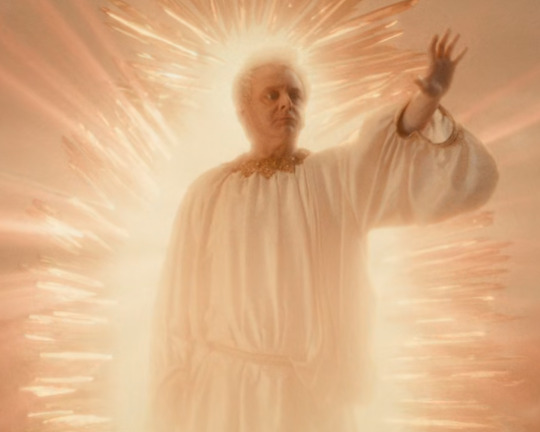

so as LWA, the oracle of all truth, has said - ep2 where aziraphale appears to crawley shows him with an aureole surrounding him, much like the multiple depictions of Our Lady of Guadalupe (above is the Virgin of Guadalupe, by Salcedo, 1779). other depictions/notable copies of the original however include:

(L-R: de Arellano, 1691, Gonzalez, c. 1698, and the original from cy/16th, upon which they're based which, as far as i can find, has no confirmed artist?).
and coming back to italian renaissance (which im slightly more familiar with), the following works show the same:

(L-R: Madonna and Child with Two Saints, Pisanello, c. 1445, The Last Judgement, Michelangelo, f. 1541, and Baptism of Christ, Verrocchio and da Vinci, c. 1475)
it is especially prevalent in christian religious art, but as LWA said it does appear to be mostly used for religious figures, and not necessarily angels or saints (most of those are depicted with halos instead). most examples, like the ones above, that ive found seem to be used exclusively for jesus and mary. in other religions such as buddhism, aureola appear to be shown in the form of a mandorla (an almond-shaped field) that surround enlightened beings, such as Buddha.
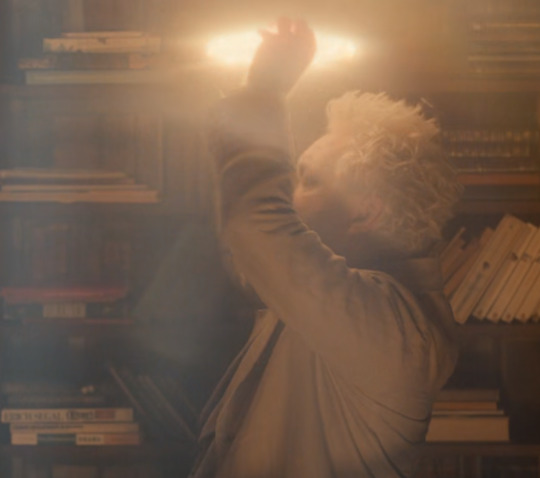

let's move onto halos; ep6 shows our funky angel removing his, and is shown in the form of a ring, emitting the same kind of light as the aureole. disks have been depicted in art from well before the time of christ, including in ancient egypt (ra) and in iran (mithra).
funnily enough, finding depictions of ring halos rather than disk/plate ones was actually quite difficult? either way - above shows Virgin of the Rocks by da Vinci, f. 1486, shows a subtle but clear ring halo over Mary's head. keeping with the cy/15-16th onwards for fair comparison, showing a combination of disk and ring halos:

(L-R: Branchini Madonna, di Paolo, 1427, Madonna of the Book, Botticelli, c. 1481, and Deposition of Christ, Raphael, 1507)
these all again are examples depicting christ and mary, so what about angels? i found the best example to look at is the annunciation to mary, as this was the subject of a number of notable pieces in the same time period:

(L-R: da Vinci, f. 1476, Fra Angelico, 1450, and Botticelli c. 1490)
all show gabriel with a halo around their head, as opposed to an aureole. the one that fascinated me though is botticelli; there is relatively little known about his depictions of the annunciation, but there are multiple - the above is in glasgow, there is another in new york, and the last is the Cestello Annunciation). however, in the first two, glasgow and new york, there is a clear feature of an aureole-type shaft of light coming from behind gabriel, and shining upon mary.
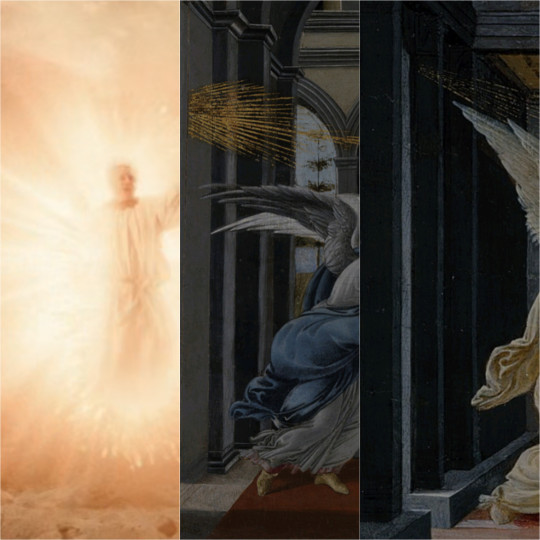
i certainly think that it's mostly representative of god's gift being bestowed on her, ("The Holy Ghost shall come upon thee, and the power of the Highest shall overshadow thee.", Luke 1:35) but the perspective of the glasgow painting almost shows like the light comes from a crack in the wall, and would suggest that aziraphale stepping out from the aureole as some sort of glorified portal is a mirror of this.
anyway, because ive rambled on long enough about nothing truly insightful; what is the point in these two different displays? well, from my research, it seems to be that aureola are used to surround the head or the body, and iconographically represent divinity, glory and, depending on the subject/context, enlightenment.
but given that it has largely been reserved in art for the depictions of the holy trinity as well as mary, to outright use it in connection with aziraphale seems... strange. in this particular scene, or part of his story, why has he been purposefully elevated to the same level of importance and power? we have no reason to suspect from the ensuing dialogue that god sent aziraphale deliberately in her name to thwart crowley, carrying her power... or did she?
the halo however appears to be specifically used for instances of depicting angels or saints (in the case of gabriel and various apostles in multiple artworks), as well as jesus and mary. so that to me would suggest that halos are somewhat specifically meant to represent innate saintliness and holiness, inherent divine nature. were specifically touched by god's grace and love, and were embodiments of god's will.
what this necessarily means in relation to aziraphale though, beyond him obviously being an angel, a representative of the heavenly host, and a messenger of god's will etc... im not entirely sure.
there is presumably no reason for him to be depicted with an aureole unless, as LWA suggests, it's to draw parallels to artwork where mary is especially shown as having one. but in the context of s2 (and the job minisode), isn't this a little out of field?
another thing - aziraphale does seem to be able to turn it on and off like a tap, suggesting that it's there in the narrative for sheer Impressiveness, to Look The Part, in front of a demon... so, is it only for design purposes, because cinematically it's bloody cool to look at? or is it meant to give insight into aziraphale's thoughts and beliefs?
with it, would he (in aziraphale's mind, bless) look intimating enough to thwart crawley's 'nefarious plan' with minimal effort? possibly, but i doubt it; im a pretty firm believer in Reasons for certain design choices, especially ones that would take a lot of post-production work to animate. so, could aziraphale have chosen to appear with the aureole, to be suitably intimidating, but after having his faith in god's will shaken after the events of job, chose not to manifest it again, because its symbolism no longer rings true for him?
#this response was an insane amount of effort#especially whilst melting in 28c heat#good omens#ask#everyone say thank you to LWA for another stellar observation and insight#fun fact: i read 'job robes' as jobes and now they will only ever be jobes to me#jobes (job robes)#halo theory#mary/pieta spec#s2 meta#costume meta
50 notes
·
View notes